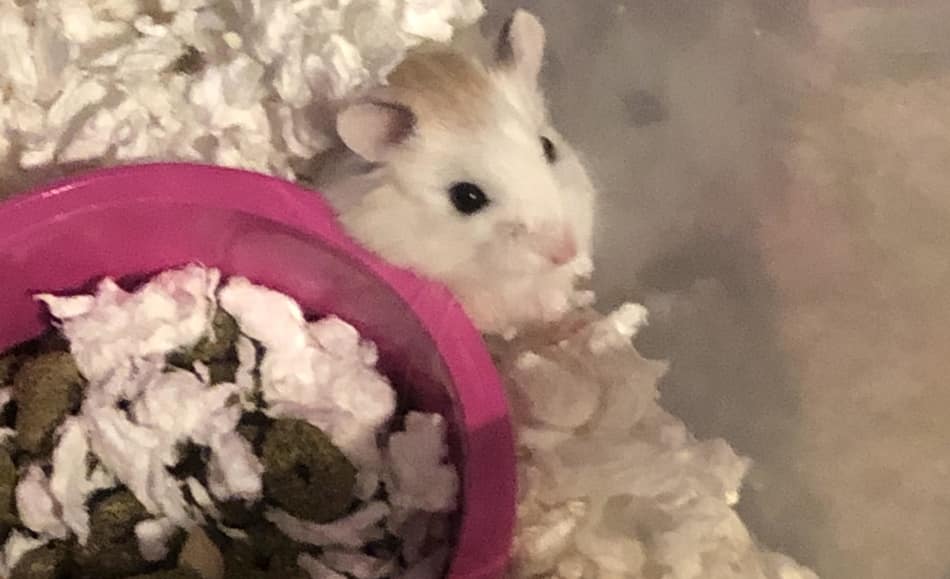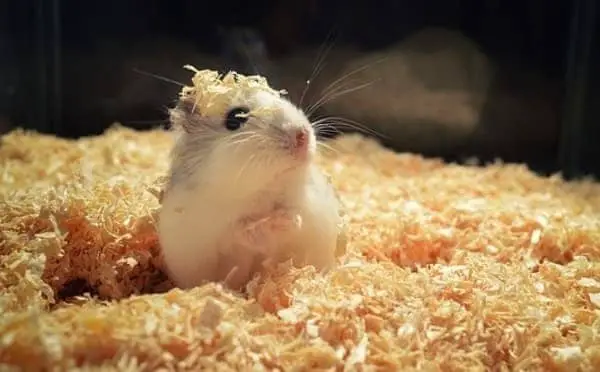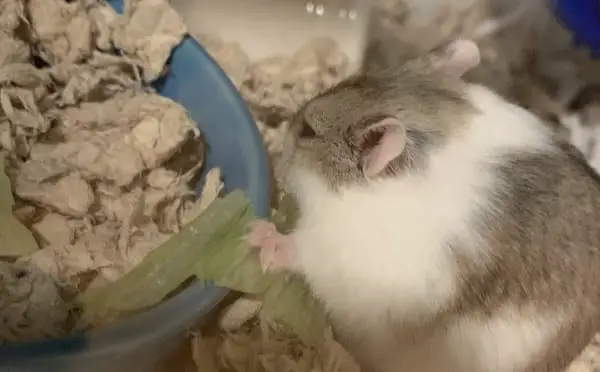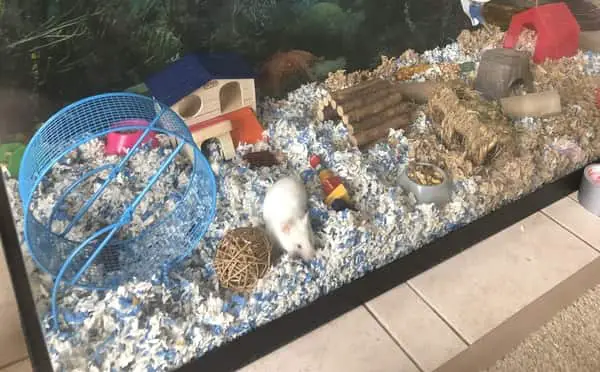Having a pet hamster at home is big fun in a tiny, furry package. For such small creatures, they have a lot of personality and even more energy. As fun as they are to interact with and observe, they can be equally as puzzling with behaviors like covering their food bowl with bedding. Not to worry, however, as this behavior most likely is completely normal.
So, why does my hamster put bedding in her food bowl? The most likely reason for this behavior is your hamster’s natural desire to hoard or stash its food, which is entirely normal. There are some other things that could also be driving the behavior, most of which are no cause for concern.
This article will examine the hamster’s natural drive to hoard its food, its instinct for burrowing, the potential for boredom, and how environmental changes could be driving certain behaviors.
Hoarding and Stashing
When most people think of hamsters, they picture tiny household companions running through a series of colorful tubes in an air-conditioned home. What they might not imagine is a hardy little creature roughing it in a dry, arid desert or windy, rocky steppe, but this is exactly what hamsters look like in the wild.
On top of potentially harsh weather conditions in environments like this, wild hamsters contend regularly with food scarcity, especially during certain seasons. Because of this, they have a natural drive to forage and store large amounts of food in their burrows for later consumption.
Domestic hamsters have only been living in our homes since the mid-1900s, so the instincts that drive them are just as strong as those of their outdoor cousins. This means your hamster might demonstrate some interesting hoarding behaviors with its food and food bowl.
Many domestic hamsters will load up their cheeks with favorite pieces of food and take it somewhere to store such as hides, tubes, under beds, or simply buried in a corner under their bedding. Others will cover up their entire food bowl as a way of hoarding the whole stash at once rather than taking individual bits back to different places.
This behavior is entirely normal, to be expected, and should even be encouraged. A hamster acting on its natural instincts usually means it is happy and content. There is no need to uncover your pet’s food bowl unless you are trying to fill it again; a hamster’s sense of smell is quite strong, and they will be able to find it regardless of how much bedding they have thrown on top of it.
Additionally, your hamster’s hoarding habits are no reflection of your feeding schedule so no need to worry that you are underfeeding. Your pocket-sized pal is simply acting on its strong instinct to store food, whether it perceives that food is in abundance or not.
Hoarding aside, your hamster is also hard-wired to dig and burrow; another instinct that may be driving its quirky behavior.
Burrowing
As mentioned above, wild hamsters live in burrows which consist of underground tunnels and rooms for various uses. Living this way helps protect hamsters from extreme high or low temperatures and other weather conditions as well as predators in their environments.
Further, this subterranean lifestyle helps hamsters keep their big stashes of food safe and dry, as they use some of these rooms for food storage. Other rooms are used for sleeping, toileting, or housing baby hamsters and keeping them safe and warm.
In addition to the natural drive for hoarding, the burrowing instinct in our homebound hamsters is quite strong as well. This means your hamster likely burrows in its bedding or in its hide frequently, which is completely normal and healthy behavior.
Why is My Hamster Digging in His Food Bowl?
If you have an avid digger, it might be tossing bedding on its food bowl unintentionally as it excavates. Conversely, because hamsters utilize their burrows and tunnels for food storage, it might be trying to create a burrow around its food bowl since it can only dig so far down in its enclosure. In either case, this behavior certainly is no cause for concern.
Encourage your hamster’s healthy instinctual drive by partitioning a portion of its enclosure with extra bedding, or by adding a box dedicated specifically to digging, to give your pal even more options for one of its favorite hobbies. Having more digging opportunities may also help ward off boredom, which could be another potential factor in your hamster’s food-burying habit.
Boredom
Hamsters have an enormous amount of energy packed into those little furry bodies, so if they are not offered enough stimuli during their day, boredom can set in quite quickly. Our companion’s wild brethren spend a lot of time excavating their tunnels and burrows and scampering around foraging for food.
Additionally, as prey animals, wild hamsters are always on alert with their keen senses of hearing and smell. Finally, a hamster’s diet, both in the wild and at home, is quite high-energy with lots of carbohydrates. These things all add up to a lot of potential energy needing to be burned off throughout the day.
Domestic hamsters do not have as many opportunities to burn all that energy the way their wild counterparts can, so they rely on us to provide plenty of stimulation for them.
This can come in the form of interconnecting tunnels through which to scamper and scurry, a running wheel for hamster marathons, chew blocks, toys, and even hamster balls in which to explore the rest of your home. If your hamster does not have enough stimulation, digging in its enclosure may be the only outlet it gets.
If that is the case, your companion may be burying its food bowl out of boredom, which can lead to stress, anxiety, and other potential complications in hamsters. If you suspect your hamster is covering its bowl out of boredom and are worried about stress, look for some of these other signs your pet may be showing you:
- Uncharacteristic hyperactivity
- Unusual or compulsive behavior (bar biting, compulsive digging, scratching)
- Uncharacteristic aggression
- Snorting, grunting, squealing
- Repeated escape attempts
- Muscle rigidity or tremors
To prevent stress from becoming an issue, try adding one or multiple of the enrichment tools listed above like tubes, wheels, or toys to your pal’s enclosure. Also consider adding a dedicated digging area as discussed in the previous paragraph to ensure your furry friend gets as much variety as possible in its daily activities.
If you have read this far and are not convinced that your pocket-sized pal is being driven by instinct or boredom when it covers its food bowl, perhaps something about its environment is driving the behavior.
Environmental Changes
Hamsters are quite sensitive to the environment around them, largely because they are prey animals. They have sharp senses to help them stay on alert for predators in the wild at almost all times, but in our homes, it is quite easy for those senses to become overwhelmed.
Hamsters are sensitive to items that generate ultrasound, consistent noise, or high frequency sounds as these can overwhelm their senses and cause a great deal of stress.
Make sure your hamster’s enclosure is away from television sets, computers, constantly running water, or other loud items, and consider putting it in another room when it comes time to vacuum.
Additionally, hamsters are nocturnal, which means they are most active in the evening and at night and are somewhat sensitive to bright light. Keep the lights lower in the room your companion is housed in, and make sure lights go on and off around the same time every day.
Your furry friend may also be reacting to a new pet in the household, especially if that pet could be considered a predator or competitor. If you recently introduced a dog, cat, or even a larger rodent or small mammal into your home, your hamster may be covering its food bowl for a few reasons, possibly as a response to the stress of having a new companion around, or to protect its stash of goodies in the hamster food bowl.
It could be trying to hide food from a potential competitor such as a rat or rabbit or attempting to conceal evidence of its presence to a potential predator such as a dog or cat. Part of the reason hamsters in the wild burrow and store food is to keep their presence hidden from predators and their food hidden from those who might steal it.
If you believe this may be causing your pet’s behavior, keep your hamster and the new addition separate for a while and allow them to slowly warm up to one another so your hamster does not become too stressed or anxious. With patience, everyone in your home will be more at ease in no time.
Conclusion
If your hamster has been burying its food bowl in bedding, it is probably just covering up its stash for later as hamsters are notorious hoarders. They are also avid diggers who are naturally compelled to burrow and create tunnels and rooms in which to store food, among other things, meaning your pet is basically making a storage room for its meals.
All these behaviors are normal and by no means do they indicate that you are underfeeding your friend. Conversely, your pocket-sized pal with pints of expendable energy may also be bored and in need of a new outlet. Boredom could lead to stress, so make sure your friend has lots of ways to burn the midnight oil.
Finally, examine the environment in which your hamster is housed to make sure it is conducive to healthy living for your friend. If your hamster is happy and healthy, burying its food in bedding should be considered just one more quirk that you can enjoy about your funny, furry little friend.





